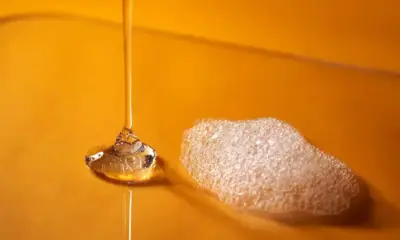Hair Care
Biomimetic natural peptides for hair restoration
Symrise has crafted a specialized process to extract natural peptides tailored for hair care. These peptides, derived from native proteins, work at the cuticle level to enhance hair smoothness, shine, and reduce split ends.

With a new approach to combat hair damage, Symrise is now focusing on the charged sites within the cortex, fostering new interactions and stabilizing broken bonds in the proteins. Biomimetic natural peptides for hair restoration are at the forefront of this innovation, effectively revitalizing hair structure.
Hair is composed of approximately 95% protein, which exists at various levels within the hair fiber: in the cuticles, the CMC (intercellular cement), the cortex, and the medulla. Therefore, comprehending the role and properties of proteins in hair is crucial. The quality of hair protein directly influences its sensory attributes, appearance, strength, and resilience.
Proteins are long chains of amino acids linked together. Specifically, keratin proteins predominantly make up hair. Various types of keratin are present within the hair fiber, differing in their amino acid composition, size, length, and the three-dimensional structures they form when they fold.
In the cuticle, the primary amino acids found in keratin include cystine, serine, glycine, and proline, though their ratios vary in the cortex. This variance affects the types of interactions keratin can create at both intramolecular and intermolecular levels. The amino acids that form the keratin chain can interact and establish bonds through mechanisms such as hydrogen bonds, electrostatic interactions, disulfide bridges, and hydrophobic interactions. These bonds allow the keratin chain to adopt a specific three-dimensional structure, forming a network through mutual interaction.
In the cuticle, keratins are organized to prevent cracks from propagating along the fiber, protecting it from further damage. Beyond its protective role, the cuticle scales contribute to the hair’s sensory characteristics and appearance; smoother, shinier hair results from well-aligned and sealed cuticle scales.
Within the cortex, different amino acid interactions lead the keratin to adopt an alpha-helical structure, which organizes into microfilaments, forming macrofilaments. This structured organization provides the hair fiber with mechanical properties, ensuring strength and resilience.
Biomimetic natural peptides for hair restoration play a crucial role in addressing hair damage. Daily stressors—like washing, grooming, UV exposure, styling, bleaching, and straightening—can severely damage hair fibers, affecting both appearance and strength. Specifically, bleaching and dyeing can disrupt keratin levels and induce oxidation, compromising the bonds and interactions among the amino acids in keratin proteins and resulting in structural disorganization at both the cuticle and cortex levels.
In the cuticle, broken protein bonds weaken the keratin network, leading to the formation and detachment of cuticle scale fragments. Repeated damage can result in cuticle loss, cortex exposure, and split ends. This irregularity in scales leads to dull, less shiny hair that is difficult to manage, prone to frizz, and feels dry.
Moreover, when amino acid bonds are disrupted, charged sites develop along the fiber, impacting its hydrophobic properties. Increased damage results in hair that is more polar and hydrophilic, making it more porous and susceptible to water. This exacerbates the lifting of scales.
Within the cortex, structural disorganization affects the mechanical properties of the hair fiber, resulting in decreased strength and increased breakage. Hair becomes more hydrophilic, absorbing water easily, making it more prone to deformation during routine grooming, especially when wet.
With an understanding of how keratin is impacted by damage, Symrise has developed specific ingredients that target different levels of hair damage, offering tailored solutions for consumers. Over recent years, consumer concerns about hair damage have grown significantly. Hair is seen as a form of self-expression and a crucial aspect of an individual’s identity. People frequently color, bleach, or style their hair, akin to accessorizing clothing.
As awareness of the effects of physical and chemical treatments on hair increases, consumers look to the beauty industry for effective solutions to prevent and protect their hair while also repairing existing damage. Many individuals identify their hair as damaged, which can result from everyday grooming or more intensive treatments like heat styling and chemical processing.
Biomimetic natural peptides for hair restoration present an innovative way to address these issues. With extensive expertise in extracting native proteins through its unique ingredient, SymHair® Restore, Symrise has deepened its understanding of natural proteins and developed a specialized process to obtain these beneficial natural peptides. While this active ingredient works at the cuticle level to enhance smoothness, shine, and split ends, it also provides solutions for repairing hair from the inside out.
By employing a fresh strategy to tackle hair damage, Symrise targets the charged sites within the cortex to create new interactions and stabilize broken protein bonds. This approach helps to partially restore the structural integrity of the hair fiber, enhancing strength and resistance. To effectively interact with damaged areas, very small molecules are essential, possessing specific polar properties to ensure successful bonding.
Peptides are already recognized for their skin benefits in the cosmetic industry and are increasingly acknowledged for their efficacy in hair care. Due to their smaller molecular weight, these peptides are more likely to diffuse through the cuticles and intercellular cement, reaching the cortical zone effectively.
Consumers now associate peptides with effective solutions against hair damage, and Symrise illustrates how peptides derived from natural sources can deliver specific actions and benefits for all levels of hair damage. SymProt’in® Oat and SymProt’in Lupin penetrate deeply into the hair fiber, targeting damaged and charged sites to establish new interactions and restore structural integrity for improved strength and resistance.
Natural and biomimetic peptides are obtained through biotechnological and enzymatic extraction methods. These environmentally friendly processes utilize various sources to create sustainable biomimetic peptides. Oat and lupin were chosen for their unique protein content.
Using a tailored combination of enzymes, Symrise extracts very specific and unique peptides. Each active ingredient boasts a distinct profile in terms of peptides and amino acid composition, allowing for targeted actions on the hair fiber.
These peptides primarily consist of di- and tripeptides with very low molecular weights, which ensures their effective penetration into the hair fiber. Additionally, to achieve good diffusion into the cortex and effective deposition, even post-rinsing, the peptides must exhibit a strong affinity for the hair, especially in damaged areas.
This ability to penetrate was confirmed using MALDI-TOF-TOF mass spectrometry, which analyzed the inner parts of hair fibers treated with oat peptide extract compared to untreated, bleached hair. The presence of peptides in treated fibers was demonstrated, validating the ingredient’s capability to deeply penetrate the hair structure. Further tests, including tensile, breakage, and fatigue assessments, confirmed the recovery of mechanical properties, indicating that the peptides could effectively interact with damaged areas within the cortex.
The oat peptide ingredient adapts to the level of damage within the hair fiber. The greater the damage, the more charged the fiber becomes, enabling peptides to interact and restore the hair’s structural integrity. This ingredient aims to enhance hair strength and resistance while reducing breakage in severely bleached hair.
A fatigue test on hair bleached three times demonstrated the ingredient’s capacity to adapt to damage levels and restore highly compromised fibers. Applied at 2% in shampoos and conditioners, it resulted in a 33% increase in hair resistance.
SymProt’in Lupin, rich in di- and tripeptides with a significant amount of arginine, offers additional benefits. Arginine is one of the main amino acids found in keratin proteins, making this ingredient especially valuable for hair care. Thanks to its low molecular weight and polarity, lupin peptides can penetrate the cortex and interact with damaged areas, assisting in keratin repair and damage prevention.
Differential scanning calorimetry (DSC) analysis was performed to evaluate the efficacy of lupin peptides in repairing keratin within hair fibers. This analysis measures the energy variations during phase transitions, which relate to the amount and quality of keratin present.
In tests where the active ingredient was applied at 1% in shampoos and conditioners on bleached hair, the enthalpy of denaturation was assessed. The analysis confirmed that lupin peptides efficiently stabilize and restore the structural integrity of damaged hair fibers by interacting with amino acid residues in the cortex. Comparisons with animal-derived proteins, such as hydrolyzed collagen and keratin, showed that lupin peptides performed as well as hydrolyzed keratin and even surpassed hydrolyzed collagen.
In addition to restoring keratin quality, lupin peptides provide a sustainable, green alternative to animal-derived proteins. Besides mass restoration benefits, this ingredient was also tested in tensile assessments, revealing improvements in the mechanical properties of damaged hair. The results indicated a significant restoration of strength and resistance, thereby reducing the risk of breakage.





















